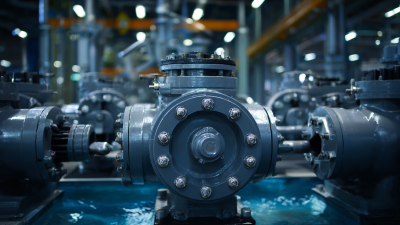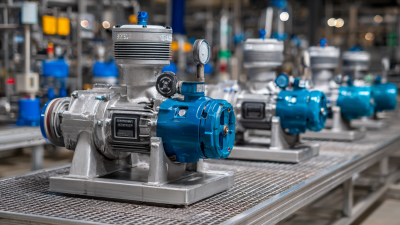Contact Us
Maximizing Efficiency: The Role of Boiler Condensate Pumps in Energy Savings and System Performance
In modern industrial settings, maximizing energy efficiency is paramount, especially in systems reliant on steam processing. The incorporation of a high-quality boiler condensate pump can significantly enhance system performance while driving down operational costs. According to a report by the U.S. Department of Energy, steam systems account for nearly 33% of industrial energy use, highlighting the need for effective management of steam and condensate.

A properly functioning boiler condensate pump plays a crucial role in this process by efficiently recovering and returning condensate for reuse, thus enhancing thermal efficiency and reducing water treatment expenses. Moreover, a study published in the Journal of Cleaner Production indicates that optimal condensate management can lead to energy savings of up to 20% in steam systems. As industries strive to meet sustainability goals, understanding and implementing best practices for boiler condensate pumps is essential for achieving significant operational savings and improving overall efficiency.
Understanding Boiler Condensate Pumps: Key Components of Efficient Systems
Boiler condensate pumps play a critical role in enhancing the efficiency of steam systems. These pumps are designed to collect and discharge the condensate produced during the steam generation process back to the boiler. By effectively managing this condensate, they not only help maintain the system’s water balance but also reduce the energy required to operate the boiler. This is essential because returning hot condensate directly to the boiler can significantly lower the energy needed to heat incoming cold water, thus optimizing overall system performance.
In addition to energy savings, boiler condensate pumps contribute to the longevity of boiler systems. Utilizing automatic and properly sized condensate pumps minimizes wear and tear on other components, such as valves and steam traps. Moreover, maintaining a consistent flow of condensate helps prevent corrosion and scaling within the boiler, ultimately leading to fewer outages and lower maintenance costs. Overall, understanding the functions and benefits of boiler condensate pumps is crucial for anyone looking to improve energy efficiency in industrial steam systems.

Energy Savings through Effective Condensate Return Strategies
Effective condensate return strategies play a crucial role in maximizing energy savings within steam systems. By efficiently returning condensate to the boiler, facilities can significantly reduce the energy required to produce fresh steam. This process not only minimizes water waste but also ensures that valuable thermal energy is recaptured and reused, contributing to overall system efficiency. Implementing a well-designed condensate return system reduces the need for additional makeup water, which can lead to further cost savings related to water treatment and heating.
Additionally, the selection and operation of boiler condensate pumps are vital in enhancing system performance. These pumps need to be appropriately sized and strategically positioned to facilitate optimal flow rates, which prevents condensation from lingering in the steam distribution system and promotes quicker return to the boiler. Advanced technologies, such as variable speed drives and energy-efficient pump designs, can further optimize performance, allowing for real-time adjustments based on system demands. By focusing on these effective return strategies and pump technologies, businesses can achieve substantial reductions in energy consumption, while also extending the lifecycle of their heating equipment.
Optimizing System Performance: The Impact of Proper Pump Selection
Selecting the right condensate pump is crucial for optimizing the performance of a boiler system. Proper pump selection ensures that condensate is efficiently removed from the boiler, preventing water accumulation that can lead to energy losses and reduced operational efficiency. A well-chosen pump can handle varying flow rates and pressures, accommodating changes in the system without wasting energy. This adaptability not only maximizes the energy savings but also enhances the overall reliability and longevity of the system components.
In addition, the compatibility of the pump with the specific boiler and heating system design plays a significant role in performance optimization. Factors such as pump material, size, and design features should align with the operational requirements to minimize maintenance needs and avoid system downtimes. By prioritizing proper pump selection, facility managers can ensure more efficient water handling, leading to improved thermal performance and reduced energy consumption. Therefore, investing in the right condensate pump is a vital step in achieving both energy efficiency and robust system functionality.
Maximizing Efficiency: The Role of Boiler Condensate Pumps in Energy Savings
Monitoring and Maintenance Best Practices for Condensate Pumps
 Monitoring and maintaining boiler condensate pumps are crucial for optimizing their performance and ensuring energy efficiency within a steam system. According to the U.S. Department of Energy, improperly maintained condensate systems can lead to energy losses of up to 20%. Regular inspection and testing of these pumps not only help identify malfunctions early but also ensure that the system operates at its maximum efficiency.
Implementing a schedule for routine maintenance that includes checking for leaks, ensuring the pump is free of blockages, and verifying that it operates at the correct pressure can significantly enhance performance.
Monitoring and maintaining boiler condensate pumps are crucial for optimizing their performance and ensuring energy efficiency within a steam system. According to the U.S. Department of Energy, improperly maintained condensate systems can lead to energy losses of up to 20%. Regular inspection and testing of these pumps not only help identify malfunctions early but also ensure that the system operates at its maximum efficiency.
Implementing a schedule for routine maintenance that includes checking for leaks, ensuring the pump is free of blockages, and verifying that it operates at the correct pressure can significantly enhance performance.
Moreover, advanced monitoring technologies, such as IoT sensors, can provide real-time data on pump performance and energy usage. A study by the International Energy Agency highlights that such technologies can result in a 15% increase in energy efficiency when utilized effectively. By analyzing operational data, maintenance teams can make informed decisions to optimize the system and reduce downtime, leading to substantial cost savings.
Overall, establishing robust monitoring and maintenance protocols is essential for leveraging the full benefits of condensate pumps in energy savings and system performance.
Case Studies: Successful Energy Savings Achieved with Condensate Pumps
In many industrial settings, optimizing energy use is crucial for both sustainability and profitability. Case studies have shown that the implementation of boiler condensate pumps can lead to significant energy savings. For instance, a manufacturing facility that integrated modern condensate pumping systems reported a 20% reduction in their overall energy consumption. The condensate pumps facilitated the recovery and reuse of steam, which not only enhanced the efficiency of their heating processes but also reduced the burden on their boiler system.
Another compelling example comes from a food processing plant that replaced their outdated condensate handling system with high-efficiency pumps. The result was a notable decrease in water and energy costs, achieving a payback period of less than two years. By effectively managing the condensate, this facility was able to maintain optimal steam pressure and improve overall system performance, proving that the strategic deployment of condensate pumps can yield both immediate and long-term benefits for energy savings and operational efficiency.
Related Posts
-

The Essential Guide to Choosing the Right Boiler Condensate Pump for Your Home
-

The Future of Industrial Centrifugal Pumps Innovations and Trends You Need to Know
-

Understanding the Mechanisms and Applications of High Head Pumps in Modern Industry
-

Understanding the Efficiency of High Pressure Centrifugal Pumps in Industrial Applications
